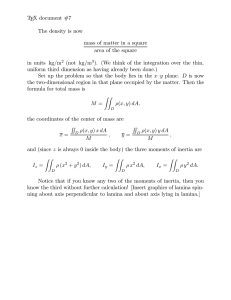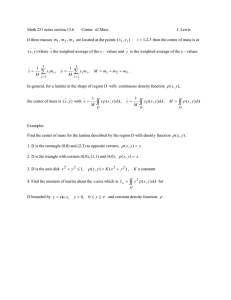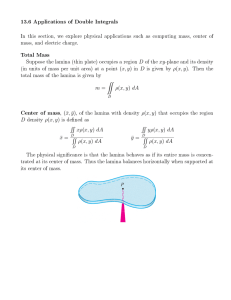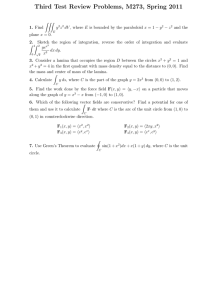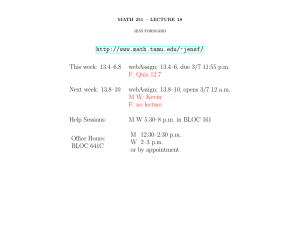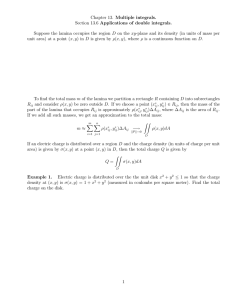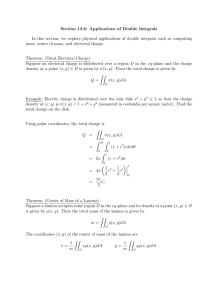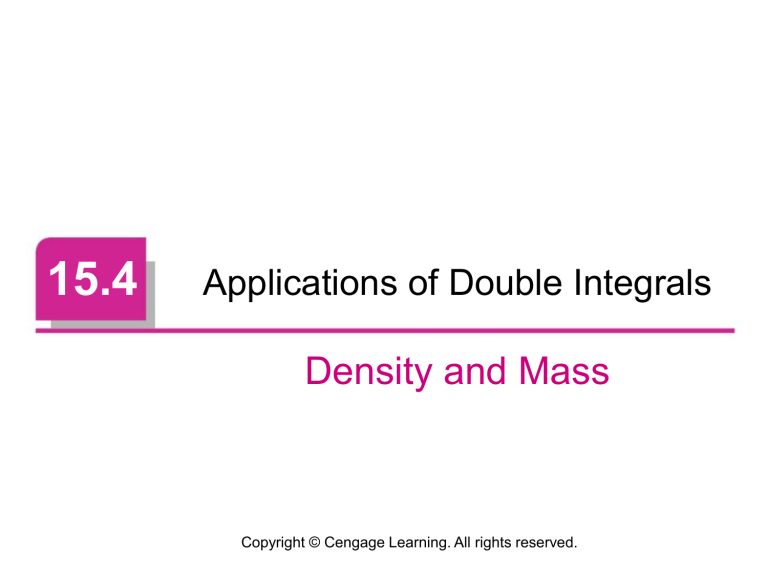
15.4 Applications of Double Integrals Density and Mass Copyright © Cengage Learning. All rights reserved. Density and Mass In physics, a moment is an expression involving the product of a distance and a physical quantity. Moment of force (力矩) We can use double integrals to compute moments and the center of mass of a thin plate or lamina with variable density. Suppose the lamina (薄片) occupies a region D of the xyplane and its density (in units of mass per unit area) at a point (x, y) in D is given by (x, y), where is a continuous function on D. Figure 1 2 Density and Mass This means that the density is where Δm and ΔA are the mass and area of a small rectangle that contains (x, y) and the limit is taken as the dimensions of the rectangle approach 0. (See Figure 1.) Figure 1 3 Density and Mass To find the total mass m of the lamina we divide a rectangle R containing D into subrectangles Rij of the same size (as in Figure 2) and consider (x, y) to be 0 outside D. If we choose a point in Rij, then the mass of the part of the lamina that occupies Rij is approximately ΔA, where ΔA is the area of Rij. Figure 2 If we add all such masses, we get an approximation to the total mass: 4 Density and Mass If we now increase the number of subrectangles, we obtain the total mass m of the lamina as the limiting value of the approximations: Physicists also consider other types of density that can be treated in the same manner. 5 Density and Mass For example, if an electric charge is distributed over a region D and the charge density 電荷密度 (in units of charge per unit area) is given by (x, y) at a point (x, y) in D, then the total charge Q is given by 6 Example 1 Charge is distributed over the triangular region D in Figure 3 so that the charge density at (x, y) is (x, y) = xy, measured in coulombs per square meter (C/m2). Find the total charge. Figure 3 (Coulombs) 7 Moments and Centers of Mass 8 Moments and Centers of Mass Here we consider a lamina with variable density. Suppose the lamina occupies a region D and has density function (x, y). Recall that we defined the moment of a particle about an axis as the product of its mass and its directed distance from the axis. (粒子相對於一個軸的力矩,是質量和到此軸 的有向距離的乘積) We divide D into small rectangles. Figure 1 9 Moments and Centers of Mass Then the mass of Rij is approximately A, so we can approximate the moment of Rij with respect to the x-axis by The distance to the x-axis is yij If we now add these quantities and take the limit as the number of subrectangles becomes large, we obtain the moment of the entire lamina about the x-axis: (整個薄片相對 於x軸的力矩) 10 Moments and Centers of Mass Similarly, the moment about the y-axis is As before, we define the center of mass (𝑥, 𝑦), so that 𝑚𝑥 = 𝑀𝑦 and 𝑚𝑦 = 𝑀𝑥 . The physical significance is that the lamina behaves as if its entire mass is concentrated at its center of mass. (可視為所有質量m都集中在質心,所以總質量乘上質心到軸 的有向距離會等於總力矩,所以 𝑚𝑥 = 𝑀𝑦 和 𝑚𝑦 = 𝑀𝑥 。 如此可求得質心坐標 𝑥 = 𝑀𝑦 /𝑚 和 𝑦 = 𝑀𝑥 /𝑚 11 Moments and Centers of Mass Thus the lamina balances horizontally when supported at its center of mass (see Figure 4). Figure 4 12
